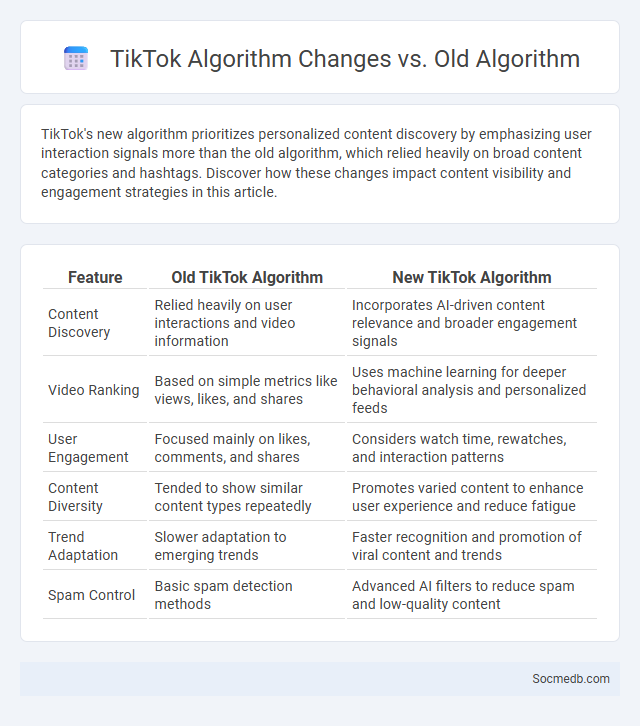
Photo illustration: TikTok Algorithm Change vs Old Algorithm
TikTok's new algorithm prioritizes personalized content discovery by emphasizing user interaction signals more than the old algorithm, which relied heavily on broad content categories and hashtags. Discover how these changes impact content visibility and engagement strategies in this article.
Table of Comparison
| Feature | Old TikTok Algorithm | New TikTok Algorithm |
|---|---|---|
| Content Discovery | Relied heavily on user interactions and video information | Incorporates AI-driven content relevance and broader engagement signals |
| Video Ranking | Based on simple metrics like views, likes, and shares | Uses machine learning for deeper behavioral analysis and personalized feeds |
| User Engagement | Focused mainly on likes, comments, and shares | Considers watch time, rewatches, and interaction patterns |
| Content Diversity | Tended to show similar content types repeatedly | Promotes varied content to enhance user experience and reduce fatigue |
| Trend Adaptation | Slower adaptation to emerging trends | Faster recognition and promotion of viral content and trends |
| Spam Control | Basic spam detection methods | Advanced AI filters to reduce spam and low-quality content |
Introduction to TikTok Algorithms
TikTok's algorithm analyzes user interactions, video information, and device settings to provide a personalized content feed. It prioritizes factors such as watch time, likes, shares, comments, and new user behavior to optimize engagement and relevance. Understanding how your activity influences these signals can help you tailor content and increase visibility on the platform.
Overview of the Old TikTok Algorithm
The old TikTok algorithm prioritized user interactions such as likes, comments, shares, and watch time to curate personalized content feeds. It heavily relied on video information including captions, hashtags, and sounds to categorize and recommend videos. Early version of the algorithm emphasized rapid content virality by promoting new videos to a small test group before scaling visibility based on engagement metrics.
Key Features of the New TikTok Algorithm
The new TikTok algorithm prioritizes personalized content discovery by analyzing user interaction patterns such as video completion rates, likes, shares, and comments to tailor your feed uniquely. It emphasizes fresh content from a diverse range of creators to increase engagement and prevent content saturation. Machine learning models in the algorithm continuously optimize real-time recommendations, ensuring that Your For You page adapts dynamically to evolving preferences and trending topics.
Comparison: Old vs New TikTok Algorithm
The old TikTok algorithm primarily relied on user interactions such as likes, shares, and watch time to curate content, emphasizing viral trends and popular sounds. The new TikTok algorithm incorporates advanced AI-driven personalization, analyzing deeper user behavior patterns, including video completions and scrolling speed, to deliver more tailored content recommendations. This shift enhances user engagement by focusing on individual preferences rather than broad popularity metrics.
How Algorithmic Bias Manifests on TikTok
Algorithmic bias on TikTok often manifests through skewed content recommendations that prioritize popular trends while marginalizing diverse voices, affecting the visibility of certain user groups. This bias can lead to the reinforcement of stereotypes and unequal content distribution, influencing the content you see based on engagement patterns that favor specific demographics. TikTok's recommendation system uses machine learning models that inadvertently amplify existing social biases present in training data, impacting the platform's inclusivity and user experience.
Impact of Algorithm Changes on User Experience
Algorithm changes on social media platforms directly influence content visibility, shaping user engagement by prioritizing personalized and relevant posts over chronological feeds. These adjustments often increase time spent on the platform but can also create echo chambers, limiting exposure to diverse viewpoints. User experience is further affected by how algorithms manage misinformation and the balance between advertising and organic content in feeds.
Addressing Algorithmic Bias: TikTok’s Efforts
TikTok is implementing advanced machine learning techniques to identify and reduce algorithmic bias in content recommendations, aiming to promote diverse and inclusive user experiences. The platform uses AI-driven audits and user feedback to continually refine its algorithms, minimizing the amplification of harmful stereotypes or marginalized viewpoints. These efforts reflect TikTok's commitment to creating a fairer digital environment by enhancing transparency and accountability in its recommendation systems.
Content Visibility: Winners and Losers of the Algorithm Shift
Content visibility on social media has drastically shifted due to recent algorithm changes, favoring authentic engagement and video content while deprioritizing clickbait and repetitive posts. Brands and creators who produce original, interactive, and community-driven content now enjoy increased reach, whereas those relying on passive consumption or keyword stuffing face dwindling exposure. Understanding these dynamics is crucial for you to adapt strategies that maximize visibility and audience connection in evolving digital landscapes.
User Reactions to TikTok Algorithm Updates
User reactions to TikTok algorithm updates often reflect concern over content visibility and engagement fluctuations, with many creators noticing shifts in their video reach and follower growth. Changes in the algorithm prioritize different types of content, leading to mixed feedback regarding discovery and audience retention. This has prompted ongoing discussions within the TikTok community on adapting strategies to maintain virality and user interaction.
Future Implications for TikTok’s Algorithm and Bias
TikTok's algorithm is expected to evolve with increasing use of artificial intelligence and machine learning to deliver more personalized content, potentially raising new challenges in mitigating algorithmic bias. Addressing bias will be crucial as the platform expands globally, requiring enhanced transparency and fairness to prevent the amplification of harmful stereotypes and misinformation. Future developments may include adaptive content moderation and user control features to create a more equitable and inclusive social media environment.
 socmedb.com
socmedb.com